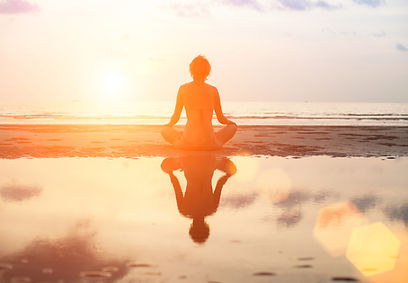
Mindfulness
Mindfulness is the experience of bringing one’s complete attention to the present moment. It is a mental exercise based on meditation that involves focusing on the present moment or an activity. It can be useful to think of mindfulness as the opposite of daydreaming or “spacing out,” since when you work on mindfulness routines daydreams are precisely what you are seeking to avoid. We use mindfulness routines to help familiarize ourselves with this state of consciousness, to enter into it and let it begin to work, especially as an antidote to anxiety.
For me, a mindfulness routine will begin by slowing down my breathing and by paying attention to my breathing as a physical and tactile experience, so that as the air enters my nose and fills my lungs I can feel it, and sometimes smell it, and taste it.
At this point, a few things begin to happen, usually starting with an awareness of tension in my body at one or more parts, which I had not noticed before. As I continue to breathe and focus on my breathing, I also begin to release the tension I have just been made aware of, letting it go. It’s easier to let go of that tension at this point because I’m breathing slowly, I’m making a conscious effort to relax, and most importantly I’m not thinking about stressful subjects like bills, work, traffic, deadlines, family drama or whatever.
Everyone will have different points of tension, which for me are typically found in the solar plexus, and sometimes my shoulders and legs. Another thing I can expect will happen during a mindfulness routine is that I am more aware of the environment so that I hear various noises I had automatically tuned out before. In nature, these may be sounds of the wind in the trees or of birds singing, while in the city they would be the sounds of traffic. In an office the sounds of heating units and telephones are typical. All are elements of our auditory environment we typically tune out, but in mindfulness routines, they come back to us, not as annoying distractions, but for what they are. I take note of these sounds and bring my attention back to my breath.
Now, some of us are daydreamers by nature, and this can make mindfulness especially challenging since our minds naturally fall into a daydreaming routine that dispels mindfulness.
Daydreaming has its uses, and I never kick myself when my mindfulness routines lapse into daydreams because of all the good daydreaming can do in identifying, if not dispelling anxieties. Some times it is good just to daydream because the random thoughts which emerge can inform us of what is on our mind. However, when I want to work on a mindfulness routine I shake off the daydream and work at it some more with a renewed focus on my breathing, remembering that mindfulness routines, unlike daydreaming routines, actually do involve work, and we get better with practice. Mindfulness is like an exercise that helps us get better at the exercise itself; the more I do it, the easier it comes.
We can be mindful of focusing not just on breathing, or our sense of hearing, but on any and all of the senses. Here is a famous description of doing the dishes by Thich Nhat Han, which you can adapt to any chore or activity:
To my mind, the idea that doing dishes is unpleasant can occur only when you aren't doing them. Once you are standing in front of the sink with your sleeves rolled up and your hands in the warm water, it is really quite pleasant. I enjoy taking my time with each dish, being fully aware of the dish, the water, and each movement of my hands. I know that if I hurry in order to eat dessert sooner, the time of washing dishes will be unpleasant and not worth living. That would be a pity, for each minute, each second of life is a miracle. The dishes themselves and that fact that I am here washing them are miracles!
The reason for practicing mindfulness is to get more used to training our conscious awareness itself so that instead of getting pushed around and manipulated by particular stresses and anxieties from work or our personal lives we can push back, as it were, depriving our anxiety of the fuel it needs to ignite.

Here's a Mindfulness Exercise that I've found very helpful:
Hold a small object in your hand like a stone or a penny or anything tactile.
Close your eyes and on the count of three think only about that object- how it feels and picture it in your mind.
As soon as you find yourself thinking about anything but the object, raise one finger on the opposite hand.
Repeat the process at least three times.
Now try this:
Now do the same thing, but on the count of three instead of thinking only about the object, don’t think about it. think of anything but the object and when you find yourself thinking about it raise you finger and repeat.
Mindfulness with Jon Kabat-Zinn
Jon Kabat-Zinn is considered a pioneer in the field of Mindfulness based meditation practices for reducing stress. This is a long video but is very interesting and helpful in understanding what’s going on when we use mindfulness for stress reduction.
Simple Mindfulness With Thich Nhat Hanh
Thich Nhat Hanh is a world-renowned authority on Mindfulness Meditation. He's a little hard to understand at times but he described it very well.
Dr. Dan Siegel
Dr. Daniel Siegel is talking about “Mindsight” and how it can be used to change the physical nature of the brain. I encourage a lot of my clients to read him and I often talk about his work in sessions.